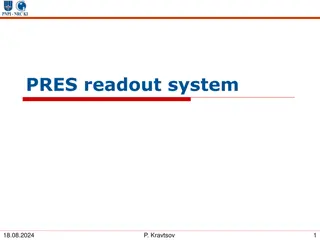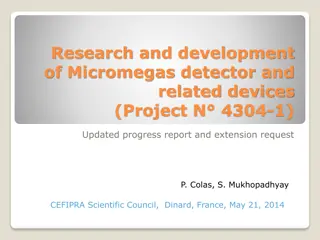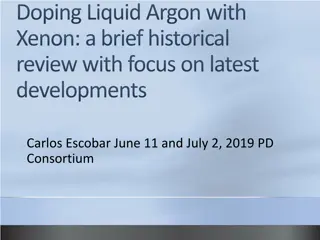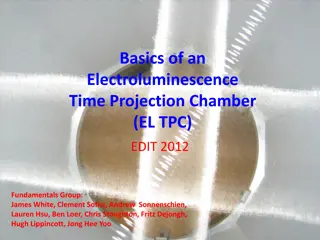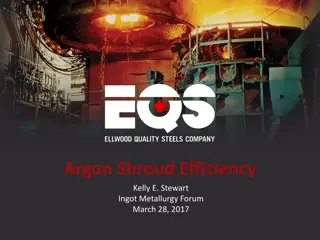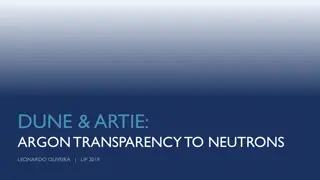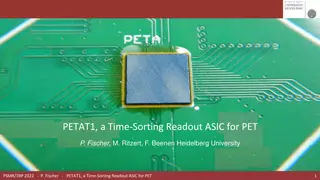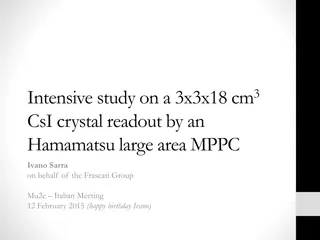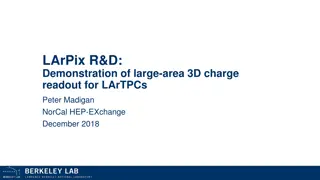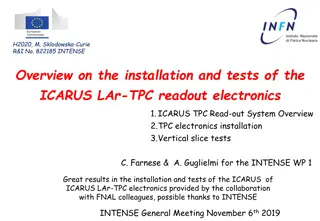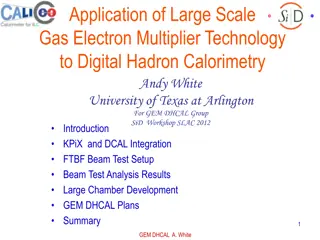Advancements in Pixel Readout R&D for Large Liquid Argon Time-Projection Chambers
Explore the latest developments in pixel readout research and development for large liquid argon time-projection chambers (LArTPCs) presented by Dan Dwyer at the CYGNUS Collaboration Meeting. Learn about signal characteristics, wire signal ambiguity, challenges in true 3D readout, and the innovative LArPix system developed at LBNL. Discover potential solutions for high-rate environments and the potential for pad-based readout in LArTPCs.
Download Presentation

Please find below an Image/Link to download the presentation.
The content on the website is provided AS IS for your information and personal use only. It may not be sold, licensed, or shared on other websites without obtaining consent from the author.If you encounter any issues during the download, it is possible that the publisher has removed the file from their server.
You are allowed to download the files provided on this website for personal or commercial use, subject to the condition that they are used lawfully. All files are the property of their respective owners.
The content on the website is provided AS IS for your information and personal use only. It may not be sold, licensed, or shared on other websites without obtaining consent from the author.
E N D
Presentation Transcript
LArPix: Pixel Readout R&D for Large Liquid Argon Time-Projection Chambers Dan Dwyer (LBNL) CYGNUS Collaboration Meeting Jan. 8, 2019
LArTPC Signals Ionization electrons: 23.6 eV per e- ~42,000 e- / MeV Recombination loss: @500V/cm MIP: ~30% Proton: ~70% Drift velocity:@500V/cm ~1.6 mm/ s Drift loss: Few-% to ~50%, depending on LAr purity and drift distance. Charge signals: (approx.) MIP: ~15k e- Multi-proton: ~250k e- (assuming 3mm pitch) (88 K) Standard detection technique: Wire planes Provide three views of interaction, each 1-D vs. Z (i.e. drift direction) Argon also an effective scintillator, provides accurate timing. arXiv:1107.5112 Dec. 9, 2018 Pixel R&D for LArTPCs 2
Wire Signal Ambiguity 2-D charge distribution (at fixed time) can be ambiguous Example: 3 GeV electron neutrino charged-current interaction in liquid argon. When tracks/showers parallel to anode plane, all wire signals are simultaneous. Simulated 2-D charge distribution Estimated 2-D charge distribution Figures generated using wirecell. DUNE Near Detector: Overwhelmed by simultaneous signals. June 15, 2018 Scalable Pixel TPC Readout 3
Neutrino Pile-up DUNE Near Detector: High-rate environment overwhelms standard readout technique. Example simulation of neutrino pile-up for a single neutrino beam pulse. Each color represents a separate neutrino interaction. Does not include background of similar rate from neutrino interactions outside LAr-TPC. Simulation by J. Sinclair True 3D readout would enable LArTPC near detector Dec. 9, 2018 Pixel R&D for LArTPCs 4
True 3D Readout Consider pad-based readout for LArTPCs, as used in gas TPCs? ALICE TPC @ CERN Pad densities of interest for LArTPCs NIM A622 (2010) 316 Key Challenges: Power: No gas amplification in LArTPCs; must rely on electronic amplification. Existing electronics (~10 mW/channel) would boil LArTPC; need ~10-2 reduction. Complexity: Requires cryogenic digital multiplexing of O(105) channels / m2. Must scale to ~100 m2 for ND. Development: Requires new cryogenic-compatible integrated circuit. Too slow/difficult to develop? Production Cost: Must be able to produce ~107 channels at a reasonable cost. Photo of ALICE TPC pads Dec. 9, 2018 Pixel R&D for LArTPCs 5
Pixel R&D: LArPix LArPix System: LBNL with ArgonCube (Univ. of Bern, UTA, etc.) - Independent front-end channel for every pixel - Pulsed-reset amplifier with self-triggered digitization and readout Digital Control RESET Front-end amplifier Standard SAR Digitizer C CONVERT SERIAL_OUT Digital Control DATA[5:0] Qin 6-b ADC CSA (from detector) HIT STROBE THRESHOLD[5:0] 6-b DAC Self-triggering Discriminator Achieve low power: avoid digitization and readout of mostly quiescent data. Dec. 9, 2018 Pixel R&D for LArTPCs 6
LArPix: Design Details Specification Number of Analog Inputs (channels) Noise Value 32 (single- ended) 300 @ 88K 500 @ 300K 4 or 45 2 ~1300 Units Note 64 (v2) ENC, e- Stipulated charge deposition is 15 ke- per MIP for a track in LAr Digitally programmable with 10 MHz master clock rate max signal ~ 250 ke-, minimum detectable signal ~ 600 e- programmable LSB, 4 mV nominal (1 ke-) Channel gain Time resolution Analog Dynamic Range V/e- s mV ADC resolution 6 bits 8 (v2) Threshold Range Threshold Resolution Channel Linearity Operating Temperature Range 0 1.8 < 1 1 88 - 300 V mV % K nominal Event Memory Depth 2048 memory locations V ~8 ms without data loss in case of track normal to pixel plane Tunable Output Signaling Level 3.3 Digital data rate Event readout time 5 5 Mb/s s With 10 MHz master clock June 15, 2018 Scalable Pixel TPC Readout 7
LArPix-v1: Readout Assembly Pixel Board: Standard printed circuit board Fits Bern Pixel Demonstrator TPC 10 different pixel geometries Complete readout assembly 28-chip LArPix data board sandwiched to pixel board 10 cm diameter, 3mm pitch, 832 pixels Dec. 9, 2018 Pixel R&D for LArTPCs 8
LArTPC Operation Demonstration of cosmic ray detection at increasing scales Apr 2018: 512-pixel system @ Bern 60 cm drift, 1 kV/cm May 2018: 832-pixel system @ LBNL Feb 2018: 128-pixel system @ LBNL 10 cm drift, 200 V/cm JINST 13 (2018) P10007 Operated stably ~1 week Dec. 9, 2018 Pixel R&D for LArTPCs 9
LArPix: Next Steps Modular pixel tile for large LArTPCs Developing LArPix-v2 ASIC for scalable assembly and improved physics performance: Increase resolution for charge signal Double number of channels per chip (32 64) Improved I/O, robust to chip failure. Substantially reduce external circuitry Improve hit timestamp accuracy Increase channel threshold tunability Improve front-end pulser Tailor characteristics of discriminator Plus a number of other changes Extend pixels edge-to-edge ASIC Packaging: Testing v1 ASIC in QFP packaged format Revising tile design assuming v2 ASIC is packaged Tile anode: Production Approach: Rely on commercial fabrication: ASICs, PCBs, tile assembly Pixel tile production cost: ~$5k / m2 (still in development) 1m 1m Dec. 9, 2018 Pixel R&D for LArTPCs 10
Next Steps: Demonstrators Roadmap of potential LArPix demonstrations at larger scales: LArIAT LArTPC ArgonCube 2x2 Demonstrator Readout area: 6.4 m2 # pixels: 400k # ASICs: 6.3k Target: Late 2019 Readout area: 0.36 m2 # pixels: 22.5k # ASICs: 350 Target: Mid 2019 First module currently under construction. Demonstrator for DUNE Near Detector Statement from DUNE: The ND CD group recommends that DUNE should have a LArTPC that is optically segmented, with a short drift and 2D pixelized readout, like the concept under study by the ArgonCube collaboration. Provide known particle beam for detailed assessment of PID and energy performance. Also pursuing LArPix readout for High-pressure Ar gas TPC Near Detector Module with FNAL, others Dec. 9, 2018 Pixel R&D for LArTPCs 11
LArPix for CYGNUS? LArPix performance well-matched to task? - Sensitivity to signals of a few thousand e- - Noise of a few hundred e- - Hit time precision of ~100 ns (tunable) - Designed for low-cost, scalable production (~5 k$ / m2) - Simple to control and operate using inexpensive commercial electronics - Position resolution (pixel pitch) at the mm-scale Insufficient for CYGNUS - Low-power, cryogenic operation Not necessary for CYGNUS - No projective ambiguities Not necessary for CYGNUS 1D vs. 2D: If you can tolerate projective ambiguities, you can achieve finer spatial resolution with 1D projective readout (e.g. strips) relative to 2D (e.g. pad, pixel) readout at a fixed channel density (cost). June 15, 2018 Scalable Pixel TPC Readout 12
Pad-Strip Hybrid? Potential approach Recast pads to small strip regions Advantages: - Provides low-capacitance, low-noise, low-power, digital scalability - Leverage large-scale low-cost DUNE production 64-channel tileable pad region 64-channel tileable strip region June 15, 2018 Scalable Pixel TPC Readout 13


